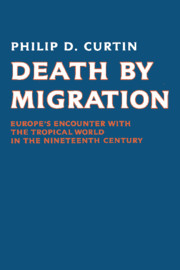Book contents
- Frontmatter
- Contents
- List of Tables, Figures, and Maps
- Preface
- List of Abbreviations
- 1 The Mortality Revolution and the Tropical World: Relocation Costs in the Early Nineteenth Century
- 2 Sanitation and Tropical Hygiene at Midcentury
- 3 Killing Diseases of the Tropical World
- 4 Relocation Costs in the Late Nineteenth Century
- 5 The Revolution in Hygiene and Tropical Medicine
- 6 The Pursuit of Disease, 1870–1914
- Conclusion
- Appendix Statistical Tables
- Bibliography
- Index
3 - Killing Diseases of the Tropical World
Published online by Cambridge University Press: 29 March 2010
- Frontmatter
- Contents
- List of Tables, Figures, and Maps
- Preface
- List of Abbreviations
- 1 The Mortality Revolution and the Tropical World: Relocation Costs in the Early Nineteenth Century
- 2 Sanitation and Tropical Hygiene at Midcentury
- 3 Killing Diseases of the Tropical World
- 4 Relocation Costs in the Late Nineteenth Century
- 5 The Revolution in Hygiene and Tropical Medicine
- 6 The Pursuit of Disease, 1870–1914
- Conclusion
- Appendix Statistical Tables
- Bibliography
- Index
Summary
Many of the principal killers of Europeans overseas were killers in Europe as well. But Europeans overseas also met a range of diseases they thought were peculiar to the tropical world – even though these might occasionally turn up in Europe in less serious form. The greatest single cause of death in the nineteenth-century tropics was malaria – as it is today. But the great epidemic diseases, yellow fever and cholera, also posed special problems, as did the tropical variants of common diseases, poisons, and deficiencies – like typhoid, lead poisoning, and beriberi. Each had its place in European medical thought and therapy during the first two-thirds of the nineteenth century. Only tuberculosis provided Europeans with a clear relocation benefit.
Malaria
The most obvious medical victory of this period was against malaria. Even in Madras, where malaria was less serious than it was in Algeria or the West Indies, deaths from fevers dropped by 60 percent between the 1840s and the 1860s, more rapidly than the general decline in mortality (see Table 1.6). In Algeria, mortality from fevers dropped by 61 percent – a significant decline, although less than the 87 percent decline in intestinal disease. By 1859–67 in the Windward and Leeward Command, “paroxysmal fevers” (which were a combination of yellow fever and malaria) dropped by more than 90 percent over the same period, and the Jamaican death rate from these fevers was even lower by the 1860s.
Quinine contributed to the decline of fever deaths everywhere. It was the first “wonder drug” that could attack a specific disease, but its acceptance was neither universal nor simple.
- Type
- Chapter
- Information
- Death by MigrationEurope's Encounter with the Tropical World in the Nineteenth Century, pp. 62 - 79Publisher: Cambridge University PressPrint publication year: 1989
- 1
- Cited by



